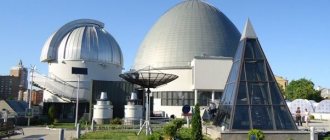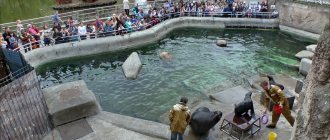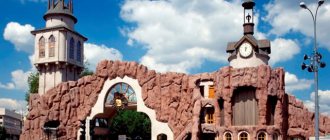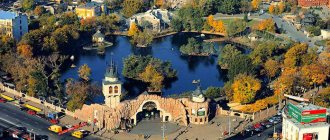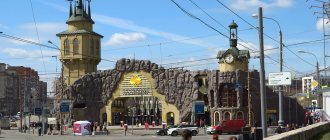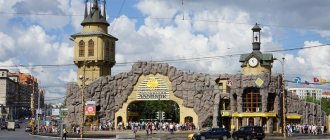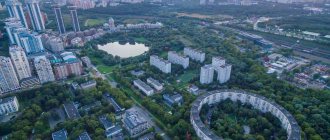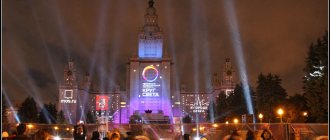The Moscow Planetarium is one of the largest in the world, and is also the oldest operating planetarium in Russia.
The planetarium building in Moscow is an architectural monument, a cultural heritage site, built in 1927–1929. It is located near the Garden Ring, within walking distance from the Barrikadnaya and Krasnopresnenskaya metro stations. Next to it is the new territory of the capital's zoo, and there are several interesting museums in this area.
© Regina Lukashina
Moscow Planetarium, 4+
Address: metro station Barrikadnaya, st. Sadovaya-Kudrinskaya, 5, building 1. + www.planetarium-moscow.ru
The Moscow Planetarium, celebrating its 90th anniversary, has been radically updated over the past few years, having undergone a large-scale reconstruction. Now this is a place of fascinating science: there is a multimedia museum Lunarium, lecture halls where young enthusiastic scientists tell children about planets and space, various thematic quests and fascinating interactive excursions dedicated to space and its researchers are held. And of course, you can observe the amazing phenomena of our Universe.
Exposition
The scientific complex has modern equipped halls and exhibition areas with expositions, and there are thematic museums. There are four levels in the building, including the lower one - underground.
Small Star Hall
The hall for children has a dome screen for showing popular science films and is often used to produce their own films. It is located on the lower (underground) level of the planetarium.
Lunarium Museum
An interactive children's museum with interesting exhibits on physics and astronomy located on the lower level, and an exhibition dedicated to the history of space exploration, which is located on the first level of the building.
© Moscow Planetarium VKontakte
Urania Museum
Includes two halls - on the first and second levels. In the first hall you can see the successively developed instruments and equipment for understanding the Universe, including instruments for sea navigation by stars. There is also an exhibition dedicated exclusively to the history of the Moscow Planetarium: books, photographs and some equipment (the legendary Planetarium devices No. 13 and No. 313). An exhibition of meteorites, globes and a model of the solar system is located in the second hall of the Urania Museum.
Video tour of the Urania Museum
Observatories of the Moscow Planetarium
Located on the second level. The largest telescope in Moscow available to visitors is located at the Great Observatory, its diameter is 300 mm. The Small Observatory has a telescope with a diameter of 400 mm, intended for research work.
"Sky Park"
An open-air astronomical site where several instruments are installed: astronomy (classical, ancient and telescopic), sundials, globes and other exhibits that once had practical significance.
Outdoor exhibition of the planetarium - “Sky Park” on Google Maps panoramas
Great Star Hall
Located on the last, third level, directly under the dome, its projector makes it possible to see more than 9 thousand celestial bodies and their movement across the sky. As in the Small Hall, 4D film screenings are held here.
© Moscow Planetarium VKontakte
Theater of Fascinating Science “Visiting the Stargazer”
One of the new projects of the Moscow Planetarium. Interactive children's programs are designed for children of different ages; individual and group applications are accepted.
There is also a photo studio and a souvenir shop “ISS” in the building. A map of the planetarium can be viewed on the official website.
Museum of Entertaining Sciences "Experimentarium", 5+
Address: metro station Sokol, Leningradsky prosp., 80, room 11. +7 experimentanium.ru
This interactive museum has a whole multimedia section dedicated to space, where you can not only learn about the secrets of the Universe, but also feel like a real astronaut. After all, you can interact with all the exhibits presented at this exhibition, completely immersing yourself in the world of astrophysics. Time flies here unnoticed, as in a real space orbit.
Polytechnic Museum (branch at VDNH), 0+
Address: metro station VDNKh, prosp. Mira, ow. 119, p. 26. +7 polymus.ru/ru/museum/exhibition_halls/rds
At the moment, the legendary Polytechnic is closed for large-scale reconstruction, and the opening of the museum is expected any day now. For now, children are told and shown about space and cosmonauts at the branch of the Polytechnic Museum at VDNKh. A temporary exhibition called “Russia Makes Itself” invites young galaxy explorers to visit one of its departments, “Beyond the Earth,” a multimedia exhibition dedicated to the latest developments in the domestic aerospace industry.
Private Observatory "Ka-Dar"
Ticket price: 500 rub. Address: village Kuzminskoye (Domodedovo urban district) Moscow region
It belongs to the Astronomy Support Foundation and is open all year round, except June and July. Tours start around midnight, and during them you can watch the stars through a telescope. You can sign up for an excursion by phone from 14:00 to 17:00 on the day of your visit: the observatory operates according to the actual weather. Much of the two-hour tour of the observatory involves viewing planets, galaxies, star clusters and other objects with a 350mm telescope.
Museum of Cosmonautics, 4+
Address: metro station VDNKh, Mira Avenue, 111. +7 (ext. 1016, ext. 1006) https://www.kosmo-museum.ru
The Museum of Cosmonautics at VDNKh successfully combines multimedia and classical museum components, and today it is one of the most grandiose museums in the country dedicated to space and astronautics.
Children here will be told not only about the history of human space exploration, but also introduced to the future prospects of astronautics. In addition, here you can become a brave explorer for a while and try to control a space simulator, an analogue of which is used during the training of real cosmonauts at the training center. Yu.A. Gagarin. The Soyuz-TMA excursion program is completely new at the museum, but has already managed to gather rave reviews from visitors.
The best seats in the auditorium
Beautiful design, convenient location and excellent acoustics, combined with a cozy atmosphere, have earned the Great Star Hall a well-deserved reputation as one of the best concert halls and iconic cultural centers of the city. Universal technical equipment and highly qualified site personnel allow us to achieve the highest quality for events of any format. An equipped entrance group, a beautiful interior, an excellent view from any place - to ensure maximum comfort for the viewer while listening to a concert in the Big Star Hall, every smallest detail has been thought out.
Scheme of the Great Star Hall:
Photos of the Great Star Hall of the Moscow Planetarium, places, best overview:
People's Observatory in Gorky Park, 5+
Address: metro Oktyabrskaya, metro Park Kultury, st. Krymsky Val, 9, building 5. +7 park-gorkogo.com/places/132
The People's Observatory in Gorky Park was opened to visitors back in 1929, but for a number of reasons it was closed for 20 years, until 2012. Now this modern scientific laboratory has two new telescopes and an automatic sliding dome, and professional astronomers and astrophysicists, participants in scientific expeditions, teach children about space and astronauts. When visiting, it is worth taking into account the weather factor - in case of cloudiness or precipitation, registration for programs is suspended.
Saint Petersburg
This is perhaps the only place on the planet where you can get the Moon from the sky. Such a program (as well as drawing up a couple’s star chart) is offered at the St. Petersburg Planetarium especially for lovers.
Photo: St. Petersburg Planetarium
However, the St. Petersburg Planetarium also has much more down-to-earth offerings. Nebulas, galaxies, star clusters, the Milky Way, the movements of the Sun and much more can be seen in the Star Hall. In addition, in the planetarium you can become a member of the crew of a spaceship and go on a virtual interplanetary journey - in the “Space Travel” hall. And in the “Planet” hall, thanks to the all-round panorama, you can make personal geographical discoveries, sink to the bottom of the ocean and explore the icy continent.
Photo: St. Petersburg Planetarium
For those who can’t wait to explore and touch everything, there is a laboratory of entertaining experiments. More than 200 studies and experiments in mechanics, optics and electricity are carried out here. You can also see the Foucault pendulum in action.
Photo: St. Petersburg Planetarium
The planetarium also has a computer-controlled telescope - especially for on-site observations.
Photo: St. Petersburg Planetarium
Development Park "Mars Station", 5+
Address: metro station ZIL, metro station Avtozavodskaya, st. Avtozavodskaya, 18 (Riviera shopping center). +7 www.marstefo.ru
If you want to find yourself on the distant red planet without leaving Moscow, then you should visit the Mars Station educational and play park. You will find yourself immediately in 2060, when humanity is actively colonizing this planet. This is not just a multimedia exhibition, but a real, working model of a research station, where any visitor becomes a research astronaut, able to look into the future of astronautics.
Central House of Aviation and Cosmonautics DOSAAF Russia 5+
Address: metro station Petrovsky Park, metro station Dynamo, st. Krasnoarmeyskaya, 4. +7 aviacosmosdom.ru
In the courtyard of this space museum in Moscow there is a unique exhibit that will immediately attract the attention of young visitors. This is the Vostok lander, the world's first manned spacecraft. During the excursions, which are structured as interactive quests, you can not only learn the history of aviation and astronautics, but also learn how to read flight maps, conduct radio communications, and try your hand at a special simulator for astronauts.
Novosibirsk
Twice a month, employees of the Novosibirsk Planetarium conduct evening sessions of astronomical observations - right in the open air. During them, everyone can learn to identify the constellations of the Northern Hemisphere, see lunar reliefs and learn about the nebulae closest to the Milky Way. Observations are carried out on the outdoor area of the planetarium from September to May.
Photo: Starover Sibiriak / Shutterstock
Also here are the astronomical programs “Morning Star”, “Rendezvous with the Moon”, “Solar Observatory” and others. The main requirement for most programs is clear weather, so keep an eye on the forecast before your visit!
Preparations for astronomical observations. Photo: Novosibirsk Planetarium
The Novosibirsk Planetarium is the largest astrophysical center in the Asian part of Russia, a park and a Foucault tower with a pendulum of the same name, which is used to demonstrate the daily rotation of the Earth. On the second floor of the building there is a Star Hall with a 16-meter dome. Its seven-degree tilt makes it possible to make images more realistic.
Especially for kids, the planetarium hosts a theatrical performance “To the Stars with Carlson.”
Photo: Novosibirsk Planetarium
However, you can admire not only the starry sky in the planetarium. Thanks to the glass facade that connects the two observatory towers, it offers panoramic views of the city and the banks of the Ob River.
Take a walk through the adjacent park: “astronomical elements” are scattered throughout the territory - sites of the Sun and planets of the solar system (Mercury, Venus, Earth, Mars, Jupiter) with satellites, as well as asteroids and comets. All of them are connected by pedestrian paths.
Landscape park adjacent to the building of the Novosibirsk Planetarium
Memorial House-Museum of Academician S.P. Koroleva, 6+
Address: metro Academician Koroleva Street, metro Exhibition Center, metro VDNKh, 1st Ostankinskaya st., 28. +7 kosmo-museum.ru/mdmk
This museum will be interesting for older children who are already in school. The story here is interesting and enthusiastic about a man with a difficult fate, but wholly devoted to his dream of conquering space, Sergei Korolev. In addition to the life path of the great design engineer, here you can learn about the history of space exploration in our country.
Planetarium of the Central House of the Russian Army named after. M. Frunze, 6+
Address: metro station Dostoevskaya, metro station Prospekt Mira, Prospekt Mira, Suvorovskaya square, 2, building 32. +7 planetarium-cc.moscow
This planetarium in Moscow is educational and cannot accommodate large groups of visitors. But in a chamber atmosphere it is easier to feel like you are in outer space, observing the stars and planets with the help of ultra-precise modern equipment.
The Planetarium also has a multimedia auditorium with 60 seats, where, sitting in a comfortable chair, you can watch the projection of stellar bodies at the moment. In addition, meetings and lectures by leading astrophysicists, engineers and cosmonauts are regularly held, where children are told about space and planets in an interesting and exciting way.
Previously, we wrote about the best interactive museums in Moscow and the children's city of professions “Masterslavl”.
- share with your friends!
How to get there
From the Moscow Planetarium to the zoo you can walk in a few minutes, which is very convenient for visiting the objects in one day.
Moscow Planetarium on Google Maps panoramas - view from the zoo
Metro to the Moscow Planetarium
You can get to the Planetarium from any of the Moscow railway stations by metro. To do this, you will need to transfer to the Tagansko-Krasnopresnenskaya line (there are stations on the Circle Line near major train stations) and get to the Barrikadnaya station.
The best transport from Red Square is also the metro, landing at the Kitay-Gorod station, 3 stops along the way.
From the Shchelkovsky bus station in Moscow, you can get there by metro with two changes at stations - at Ploshchad Revolyutsii and Tverskaya, and the journey will take about 45 minutes.
Interactive map of the Moscow metro (Yandex.Metro)
